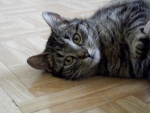I have NEVER been able to sleep on my back. Not even during titration when they wanted me to start the night off on my back but I couldn't fall asleep so they finally said: "OK you can go to sleep on your side." But now, that I'm not supposed to sleep on my back, I can't stop. I tried different pillows, even one that wrapped around me and I still found myself on my back. I even bought a fanny pack and filled it with hard balls and put it on just under my underarms. At first it worked. For a few days it kept me on my side and then suddenly one day, I woke up on my back. I guess they just sunk into my mattress. So that was the end of that.
How detrimental is it? Last night my AHI was 5.26, normally it's <5:
AI = 1.52
HI = 3.05
CAI = 0.69
PB/CSR = 3.00%
Total Leaks <45
Sleeping on my back....
- flyingwithoutwings
- Posts: 248
- Joined: Sat Oct 26, 2013 7:19 am
- Location: Central Florida
Sleeping on my back....
_________________
| Machine: PR System One REMStar 60 Series Auto CPAP Machine |
| Mask: Eson™ Nasal CPAP Mask with Headgear |
We cannot direct the wind, but we can adjust the sails!
- ChicagoGranny
- Posts: 15359
- Joined: Sun Jan 29, 2012 1:43 pm
- Location: USA
Re: Sleeping on my back....
Where did you get the idea that you are "not supposed to sleep on your back"?But now, that I'm not supposed to sleep on my back,
You may need to use an auto setting with a higher max. Do you know how to do self-titrate?
"It's not the number of breaths we take, it's the number of moments that take our breath away."
Cuando cuentes cuentos, cuenta cuántas cuentos cuentas.
Cuando cuentes cuentos, cuenta cuántas cuentos cuentas.
Re: Sleeping on my back....
Oh my God.. I thought I was the only one.. I keep waking up on my back almost every day. If i can stay my side my AHI is less than 1, but if I am on my back it isflyingwithoutwings wrote:I have NEVER been able to sleep on my back. Not even during titration when they wanted me to start the night off on my back but I couldn't fall asleep so they finally said: "OK you can go to sleep on your side." But now, that I'm not supposed to sleep on my back, I can't stop. I tried different pillows, even one that wrapped around me and I still found myself on my back. I even bought a fanny pack and filled it with hard balls and put it on just under my underarms. At first it worked. For a few days it kept me on my side and then suddenly one day, I woke up on my back. I guess they just sunk into my mattress. So that was the end of that.
How detrimental is it? Last night my AHI was 5.26, normally it's <5:
AI = 1.52
HI = 3.05
CAI = 0.69
PB/CSR = 3.00%
Total Leaks <45
ususally around 3 or 4 something. I was always a side or belly sleeper.. I have no Idea where this came from
_________________
| Machine: DreamStation BiPAP® Auto Machine |
| Humidifier: DreamStation Heated Humidifier |
| Additional Comments: Settings are IPap 23 EPap 19 |
Re: Sleeping on my back....
Last night may or may not have been a fluke in terms of the AHI. Sometimes we get those nights for no known reason.
I have always held the belief that a person should be able to sleep in any position they want to (or end up) sleeping.
Yes, some people have more events when supine...yes, some people need more pressure at times when supine but not everyone does.
And even if everyone did I would still say sleep in the position that lets you sleep. Sleep is the primary goal IMHO and the reason I use the machine is so that I can get uninterrupted sleep and if the machine is doing its job then the events are prevented and don't really matter because they never came to be.
Strapping tennis balls on my back so that I wake up when I lay on my back and remind me to stay on my side doesn't promote good sleep to me. Fragmented sleep for any reason and that includes a fanny pack of tennis balls, doesn't give us the greatest chance for restorative sleep.
Some people have worse OSA or higher pressure needs during REM stage sleep (that would be me) and we can't limit REM stage sleep nor would we want to. Why not just let the machine do its job?
It might be that a minor adjustment is needed if the pressure needs are indeed much greater when supine sleeping.
So I would think that optimizing the therapy pressure might be an easier fix that wouldn't disturb sleep unless someone has a problem with a little more pressure.
There's always a bit of give and take and its up to the individual what they want to give or take.
Look at your software graphs...see any little clustering of events? Maybe the issue is partly related to REM stage sleep too.
The normal pattern for REM stage sleep is for it to start about 90 minutes after sleep onset and increase in both frequency and duration as the night progresses with the most REM being in the wee hours of the night.
In my case a little more minimum pressure using APAP mode fixed the situation quite easily. REM or supine sleeping...doesn't matter because the machine does what it is supposed to do in the first place...prevent bad stuff from ever happening.
I have always held the belief that a person should be able to sleep in any position they want to (or end up) sleeping.
Yes, some people have more events when supine...yes, some people need more pressure at times when supine but not everyone does.
And even if everyone did I would still say sleep in the position that lets you sleep. Sleep is the primary goal IMHO and the reason I use the machine is so that I can get uninterrupted sleep and if the machine is doing its job then the events are prevented and don't really matter because they never came to be.
Strapping tennis balls on my back so that I wake up when I lay on my back and remind me to stay on my side doesn't promote good sleep to me. Fragmented sleep for any reason and that includes a fanny pack of tennis balls, doesn't give us the greatest chance for restorative sleep.
Some people have worse OSA or higher pressure needs during REM stage sleep (that would be me) and we can't limit REM stage sleep nor would we want to. Why not just let the machine do its job?
It might be that a minor adjustment is needed if the pressure needs are indeed much greater when supine sleeping.
So I would think that optimizing the therapy pressure might be an easier fix that wouldn't disturb sleep unless someone has a problem with a little more pressure.
There's always a bit of give and take and its up to the individual what they want to give or take.
Look at your software graphs...see any little clustering of events? Maybe the issue is partly related to REM stage sleep too.
The normal pattern for REM stage sleep is for it to start about 90 minutes after sleep onset and increase in both frequency and duration as the night progresses with the most REM being in the wee hours of the night.
In my case a little more minimum pressure using APAP mode fixed the situation quite easily. REM or supine sleeping...doesn't matter because the machine does what it is supposed to do in the first place...prevent bad stuff from ever happening.
_________________
| Machine: AirCurve™ 10 VAuto BiLevel Machine with HumidAir™ Heated Humidifier |
| Additional Comments: Mask Bleep Eclipse https://bleepsleep.com/the-eclipse/ |
I may have to RISE but I refuse to SHINE.
Re: Sleeping on my back....
I'm going to second everything that pugsy said.
And add this:
Many of us started sleeping in positions other than our back when we were dealing with untreated OSA, in part as a survival strategy. But when the breathing is normalized, back sleeping can be more restful, more relaxing for many people: On a proper mattress the back may be better aligned while sleeping on the back than in any other position. And if the PAP pressure is right, there's nothing wrong with sleeping on your back if that's what your body wants to do. (Case in point: One of the things that finally persuaded my Hubby to try CPAP was the idea that he'd be able to once again sleep on his back and wake up feeling GOOD rather than LOUSY. When he was younger, he always slept on his back. As his apnea started to get worse (and he's only in the mild range), his body started to prefer stomach sleeping, but his back didn't like it. Now that he's on PAP he's flipping between stomach and back sleeping based on which happens to feel more comfortable for the whole body. He's quite happy to be able to sleep on his back comfortably again.)
So (echoing pugsy), if this night was just a fluke and most of the time your AHI is where you want it, regardless of what position you're sleeping in, don't worry about it. But if you start to see a lot of days with an AHI higher than you want it and you notice you're waking up on your back more, then the easy thing to do is to allow your machine to increase the pressure a bit more and see if that allows you to sleep on the back without the AHI going too high.
And add this:
Many of us started sleeping in positions other than our back when we were dealing with untreated OSA, in part as a survival strategy. But when the breathing is normalized, back sleeping can be more restful, more relaxing for many people: On a proper mattress the back may be better aligned while sleeping on the back than in any other position. And if the PAP pressure is right, there's nothing wrong with sleeping on your back if that's what your body wants to do. (Case in point: One of the things that finally persuaded my Hubby to try CPAP was the idea that he'd be able to once again sleep on his back and wake up feeling GOOD rather than LOUSY. When he was younger, he always slept on his back. As his apnea started to get worse (and he's only in the mild range), his body started to prefer stomach sleeping, but his back didn't like it. Now that he's on PAP he's flipping between stomach and back sleeping based on which happens to feel more comfortable for the whole body. He's quite happy to be able to sleep on his back comfortably again.)
So (echoing pugsy), if this night was just a fluke and most of the time your AHI is where you want it, regardless of what position you're sleeping in, don't worry about it. But if you start to see a lot of days with an AHI higher than you want it and you notice you're waking up on your back more, then the easy thing to do is to allow your machine to increase the pressure a bit more and see if that allows you to sleep on the back without the AHI going too high.
_________________
| Machine: DreamStation BiPAP® Auto Machine |
| Mask: Swift™ FX Nasal Pillow CPAP Mask with Headgear |
| Additional Comments: PR System DreamStation and Humidifier. Max IPAP = 9, Min EPAP=4, Rise time setting = 3, minPS = 3, maxPS=5 |
- flyingwithoutwings
- Posts: 248
- Joined: Sat Oct 26, 2013 7:19 am
- Location: Central Florida
Re: Sleeping on my back....
I thought I was not supposed to sleep on my back because that would cause more apneas. Most nights I only wake up once, look at the clock and go right back to sleep but then in the morning I rarely remember what time it was that I woke up. So, since I've been waking up on my back I thought that was raising my apneas. I also thought REM was the cause because on the days I have vivid dreams my AHI is a little higher than normal (but not 5>). I also find that when I use the Swift FX (which I love) my AHI's are higher than when I use the Wisp or Nano (which I can't use right now because of congestion). HMMMMM I have to check (once I'm over this congestion) if I wake up on my back when I use the Wisp or Nano.
My machine is set at 7 - 10.5 and most of the time the 95% pressure is under 9.5.
That being said, I guess I will stop worrying about sleeping on my back and just move on. Even though my AHI last night was a bit higher, I feel less tired than I did yesterday. Go figure! I still haven't gotten over the fatigue and daytime sleepiness but I think that's due to hypothyroidism. I see my PCP on Tuesday for the results of my last blood test.
I just love CPAPTALK!
My machine is set at 7 - 10.5 and most of the time the 95% pressure is under 9.5.
That being said, I guess I will stop worrying about sleeping on my back and just move on. Even though my AHI last night was a bit higher, I feel less tired than I did yesterday. Go figure! I still haven't gotten over the fatigue and daytime sleepiness but I think that's due to hypothyroidism. I see my PCP on Tuesday for the results of my last blood test.
I just love CPAPTALK!
_________________
| Machine: PR System One REMStar 60 Series Auto CPAP Machine |
| Mask: Eson™ Nasal CPAP Mask with Headgear |
We cannot direct the wind, but we can adjust the sails!











